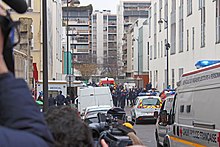
Back الهجوم على صحيفة شارلي إبدو Arabic Atentáu contra Charlie Hebdo AST «Charlie Hebdo» казияталъул редакциялда кьвагьдей AV Charlie Hebdo qətliamı Azerbaijani شارلی ابدو قیرغینی AZB Стральба ў рэдакцыі газеты «Charlie Hebdo» Byelorussian Нападение срещу „Шарли Ебдо“ Bulgarian শার্লি এবদো গুলিবর্ষণ Bengali/Bangla Lazhadeg ar Merc'her 7 a viz Genver 2015 e ti Charlie Hebdo Breton Atemptat contra Charlie Hebdo Catalan
| Charlie Hebdo shooting | |
|---|---|
| Part of the January 2015 Île-de-France attacks | |
 Police officers, emergency vehicles, and journalists at the scene two hours after the shooting | |
| Location | 10 Rue Nicolas-Appert, 11th arrondissement of Paris, France[1] |
| Coordinates | 48°51′33″N 2°22′13″E / 48.85925°N 2.37025°E |
| Date | 7 January 2015 11:30 CET (UTC+01:00) |
| Target | Charlie Hebdo employees |
Attack type | Mass shooting |
| Weapons |
|
| Deaths | 12 |
| Injured | 11 |
| Perpetrators | Al-Qaeda in the Arabian Peninsula[4] |
| Assailants | Chérif and Saïd Kouachi |
| Motive | Islamic terrorism |
On 7 January 2015, at about 11:30 a.m. in Paris, France, the employees of the French satirical weekly magazine Charlie Hebdo were targeted in a shooting attack by two French-born Algerian Muslim brothers, Saïd Kouachi and Chérif Kouachi. Armed with rifles and other weapons, the duo murdered 12 people and injured 11 others; they identified themselves as members of al-Qaeda in the Arabian Peninsula, which claimed responsibility for the attack. They fled after the shooting, triggering a manhunt, and were killed by the GIGN on 9 January. The Kouachi brothers' attack was followed by several related Islamist terrorist attacks across the Île-de-France between 7 and 9 January 2015, including the Hypercacher kosher supermarket siege, in which a French-born Malian Muslim took hostages and murdered four people (all Jews) before being killed by French commandos.
In response to the shooting, France raised its Vigipirate terror alert and deployed soldiers in Île-de-France and Picardy. A major manhunt led to the discovery of the suspects, who exchanged fire with police. The brothers took hostages at a signage company in Dammartin-en-Goële on 9 January and were shot dead when they emerged from the building firing.
On 11 January, about two million people, including more than 40 world leaders, met in Paris for a rally of national unity, and 3.7 million people joined demonstrations across France. The phrase Je suis Charlie became a common slogan of support at rallies and on social media. The staff of Charlie Hebdo continued with the publication, and the following issue print ran 7.95 million copies in six languages, compared to its typical print run of 60,000 in French only.
Charlie Hebdo is a publication that has always courted controversy with satirical attacks on political and religious leaders. It published cartoons of the Islamic prophet Muhammad in 2012, forcing France to temporarily close embassies and schools in more than 20 countries amid fears of reprisals. Its offices were firebombed in November 2011 after publishing a previous caricature of Muhammad on its cover.
On 16 December 2020, 14 people who were accomplices to both the Charlie Hebdo and Jewish supermarket attackers were convicted.[5] However, three of these accomplices were still not yet captured and were tried in absentia.[5]
- ^ "En images: à 11 h 30, des hommes armés ouvrent le feu rue Nicolas-Appert". Le Monde. 7 January 2015.
- ^ Woolf, Christopher (15 January 2015). "Where did the Paris attackers get their guns?". PRI The World. Minneapolis, US: Public Radio International. Retrieved 16 January 2015.
The weapons seen in various images of the attackers include Zastava M70 assault rifle; vz. 61 submachine gun; several Russian-designed Tokarev TT pistols and a grenade or rocket launcher – probably the Yugoslav M80 Zolja.
- ^ Withnall, Adam; Lichfield, John (7 January 2015). "Charlie Hebdo shooting: At least 12 killed as shots fired at satirical magazine's Paris office". The Independent. London. Retrieved 9 January 2015.
- ^ "Al Qaeda claims French attack, derides Paris rally". Reuters. 14 January 2015. Archived from the original on 14 January 2015. Retrieved 14 January 2015.
- ^ a b Salaün, Tangi (16 December 2020). "French court finds accomplices to Charlie Hebdo attackers guilty". Reuters. Retrieved 16 December 2020.
© MMXXIII Rich X Search. We shall prevail. All rights reserved. Rich X Search